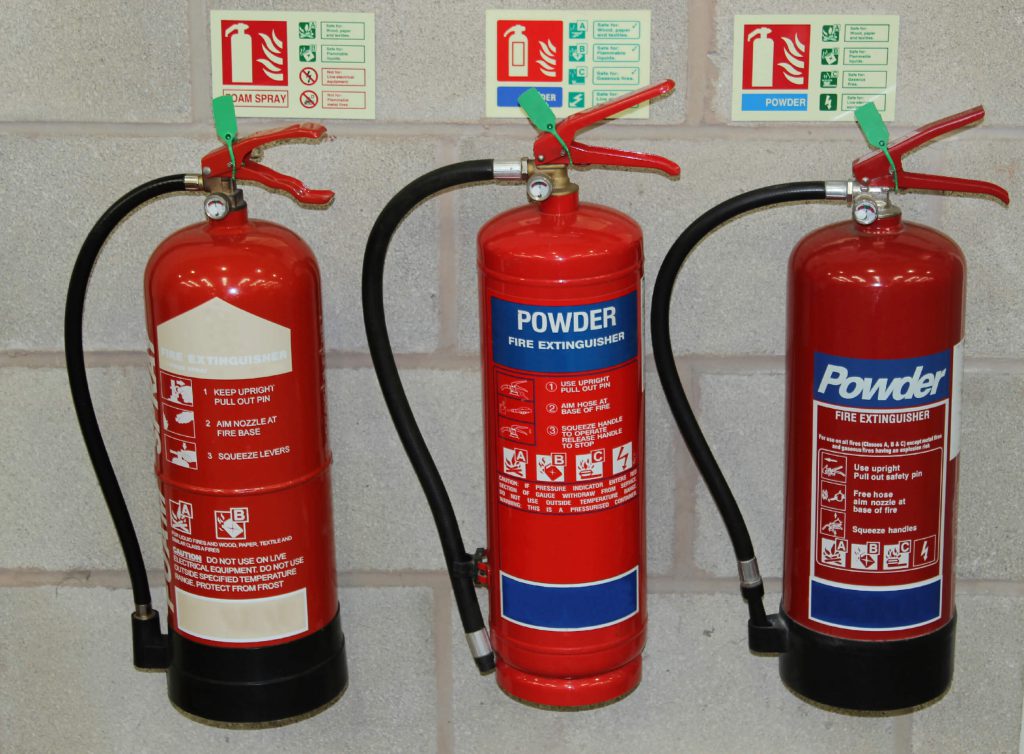Having the correct fire safety equipment in top working order is a legal requirement for any commercial environment to ensure everyone within the building is protected from the threat of a fire occurring in the property.
There are 5 main types of fire extinguishers, each designed to target specific fires so that any potential breakouts can be dealt with effectively.
For further information, also take a look at our article on how to correctly use a fire extinguisher.
Firstly, it is important to take note of which category the nature of a fire belongs to:

Class A: these fires consist of ordinary combustible materials, such as paper, wood, plastic and fabric
Class B (UK): flammable liquids, such as petrol or oil
Class C (UK): flammable gases, such as propane or methane
Class D: metals, such as aluminium or titanium
Class E (not an official UK fire class): these fires involve electrical equipment
Class F: these are typically located in the kitchen as they consist of cooking oil and fat
Each of the above classifications has a specific type of fire extinguisher design which corresponds with it to ensure the fire is tackled in the correct manner.
Water fire extinguishers, which can be located in the entirely-red cylinders, are a common and cost-effective option found in both commercial and domestic properties. The water is utilised for Class A fires to dowse the combustible materials at the source of the fire.
It may be obvious, but in the panic of a fire scenario it can easily be forgotten that water must not be used in a fire involving electrical equipment, so make sure you avoid locating water fire extinguishers in areas where Class E fires may occur.
Foam fire extinguishers, which can be identified by the red cylinder with the cream band, are more expensive than water but are also more versatile and can be used for both Class A and B fires. F
oam extinguishers are not recommended for fires involving electricity, but are safer than water if accidentally sprayed onto live electrical equipment.
Dry powder fire extinguishers are found in the red cylinders with a blue band and are utilised for their multi-purpose properties as they can be applied to Class A, B and C fires. I
t has the relevant qualities to efficiently extinguish a gas fire, but make sure you detach the gas supply first before extinguishing the fire as otherwise there can be extremely dangerous repercussions. It is also worth noting that alternative powder extinguishers are available to tackle the source of Class D metal fires.
CO2 fire extinguishers, which can be identified by the black band on the red cylinder, are the ideal solution for fires involving electrical equipment and are also effective in dowsing liquid fires.
This carbon dioxide extinguisher is one of the cleanest pieces of equipment as it leaves no residue behind after it has been used.
Finally, wet chemical extinguishers can be identified by their yellow band and are the specialist extinguisher for Class F fires.
They have the suitable qualities to tackle large burning oil fires, meaning they are perfect for the kitchen environment.
Annual fire extinguisher maintenance from the date of installation is essential to ensure they all remain in top working order, correctly filled up and safe to use.
They can pose as a serious health and safety risk if they are not properly looked after, so be sure to contact the services of a professional for total peace of mind.
Here at Protect & Detect, we specialise in supplying and installing the 5 fire extinguisher designs described in this article.
Our wealth of experience means our fully qualified team have the knowledge and expertise to carry out first-class services, ensuring you are in line with the latest legal requirements.
Further to this, we can also arrange thorough fire safety maintenance, undertaking regular testing at your convenience.
We are very proud that our high-quality services have allowed us to be awarded a large Sheltered Housing Contract with Colchester Borough Council to support their Tynetec Warden Call Systems and Fire Alarm Systems. This accomplishment reflects the efficient and thorough work we complete here at Protect & Detect, making us a company you can trust.
Protect & Detect is a leading fire safety and security company, servicing Ipswich, Colchester, Cambridge, Bury St. Edmunds, Chelmsford and beyond.
Protect & Detect offers a wide range of fire safety and security services including; fire alarms, fire extinguishers, burglar alarms, intruder alarms, fire sprinkler systems, access control, door entry systems, CCTV, barriers, nurse and warden calls. Contact our friendly team today for a quick quote.

